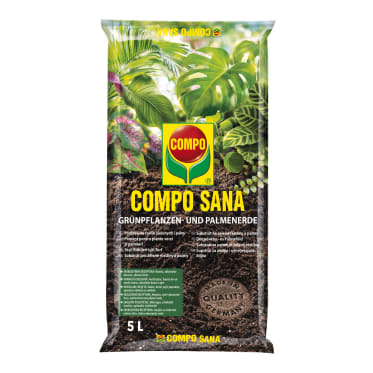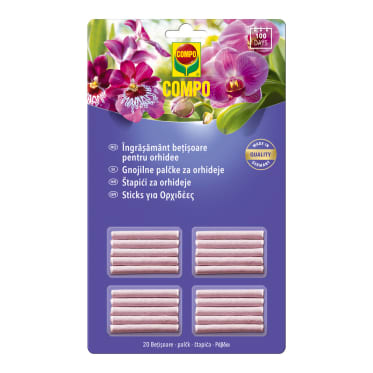Frequent search terms
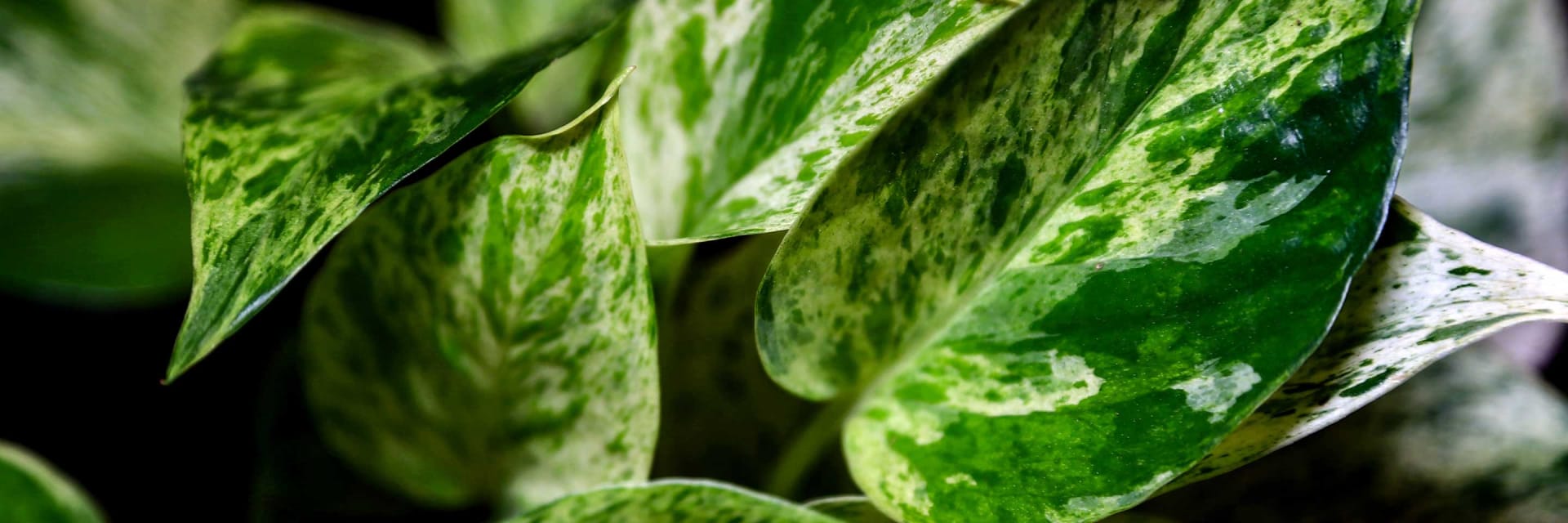
- COMPO
- Guide
- Plant Care
- Indoor plants
- Ten houseplants that don't need much light
Shade-loving plants for dark rooms
Ten houseplants that don't need much light
Shade-loving plants can enhance the look of any dark room in the blink of an eye. But which plants are suitable for the darker corners of your home? We introduce you to ten houseplants that like the shade and thrive well even in dark locations.
Shade-loving plants for the home
Which houseplants don't need much light?
Granted, no plant can do without light altogether because it's essential for the photosynthesis process. Plants that come from sunny regions in particular, like the yucca palm, aloe vera or various cactus types, need a lot of light. The sun-loving plants can quickly etiolate when they don't have sufficient light. This means that although the shoots grow quickly, they are not very strong, have no flowers and only a few leaves. In the long run, they may even wither and die. On the other hand, some houseplants are extremely good at adapting to poorly lit environments. However, you often have to settle for slower growth and less striking patterns in such cases. If you want a houseplant for a dark corner of your hallway or a poorly lit bathroom, then making the right choice is crucial. It will allow you to turn even these shaded rooms into a green oasis!
The colour and texture of the houseplant's leaves can serve as an indication of whether it can cope with poorly lit locations.
In general
The darker, more slender and larger the leaves, the better suited the houseplant is to dark corners, as it can absorb the sparse light better than other plants.
Such properties are usually found in plants that are native to dense forests. No wonder, then, that some of the shade-loving plants we want to introduce to you originally come from a rainforest.

Aspidistra
The aspidistra is an extremely robust and undemanding potted plant, making it the perfect candidate for poorly lit rooms. It will grow in the dark corners of a room and on semi-shaded or shaded balconies. Often seen in high street shops because it can cope with temperature fluctuations, draughts and dust, the aspidistra is also known as the 'cast-iron plant'. It is also a popular houseplant for shaded staircases or hallways. Water the aspidistra only moderately and regularly but at longer intervals. Ensure the surface of the soil has dried out before watering again. You can add a little liquid fertiliser to the water once a month.
Tip: Avoid using the Aspidistra elatior 'Variegata'
It needs bright light to develop its leaf stripes. These attractive leaf patterns fade in dark locations.
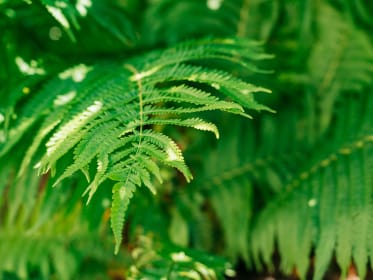
Fern
Since ferns normally grow in rather cool, tropical cloud forests, they don't need much light as a houseplant. Having said that, due to their natural environment they do appreciate relatively high humidity. Such requirements make the fern a good choice for a dark bathroom or the dark corner of a kitchen. If you want to pamper your fern, then regularly spray its leaves with a leaf care spray or water that's low in lime. You can even give it a shower with lukewarm water every now and then! The shower not only provides the leaves with sufficient moisture, but also the root ball. In addition to humidity, ferns also need quite a lot of water.

Aroid palm (Zamioculcas)
Since the aroid palm is good at adapting to different light conditions, it grows well in semi-shaded, bright spots indoors. Having said that, the aroid palm will also do well in darker locations. The deep green colour of its leaves is well preserved there. When selecting the location, it's important that you consider the room's temperature conditions. For example, the aroid palm won't feel at home in a cool hallway because it's accustomed to warmer temperatures owing to its natural habitat in the tropical forests of East Africa. Accordingly, place the aroid palm in a darker corner of the living room where it will get the desired 18-25 °C, for example. We reveal what you should keep in mind when watering and caring for an aroid palm in our plant guide.

Philodendron
The philodendron is an easy-going cohabitant. It grows extremely well in semi-shaded and shaded locations, preferably with high levels of humidity. Such conditions will usually be found in the kitchen and bathroom. Often seen scaling the trees of its natural habitat, the rainforests of South America, the philodendron is a typical climber. But there are also species which grow upright and are usually more suitable for home environments. After all, climbing philodendrons can easily grow up to three metres tall indoors. Since the philodendron grows quickly, it needs sufficient nutrients. With that in mind, you should give it a liquid fertiliser once a week during the growth period (March to October), while once a month is sufficient in the intervening dormancy phase. You can also adapt your watering routine to the growth and dormancy phases. It's advisable to water once a week during the growth phase and then extend the intervals during the dormancy phase. Watering the philodendron every two to three weeks is usually sufficient but if the indoor climate is rather dry, you should spray the leaves with water and/or a leaf care spray, especially during the winter when the plant is additionally exposed to dry heated air.
Tip
If your philodendron is literally outgrowing you, cut it back a little in March or April.

Peace lily
The peace lily is a houseplant that does well in the shade, feeling especially at home in semi-shaded and shaded locations without direct sunlight. Since it's also uncomplicated and quite easy to care for, it's a popular cohabitant in any home, regardless of whether it goes in the living room, kitchen or bathroom. Due to its natural habitat, the tropical forests of South America, the peace lily grows especially well in high levels of humidity and mild temperatures of 20-25 °C. Accordingly, the temperature should not fall below 18 °C. If the humidity in the living room is not high enough, you can help by spraying the plant regularly with lukewarm water that's low in lime. A leaf care spray gives the leaves an additional shine.
Warning! Please note that the peace lily is poisonous. If you have children or pets, we recommend a different houseplant that doesn't need much light.

Flamingo flower (Anthurium)
The flamingo flower will turn any dark corner into an eye-catcher. This exotic plant has beautifully shiny leaves, as well as striking flowers that provide a pretty splash of colour. The anthurium hails from the tropical Central and South America. Accordingly, heat – about 20-25 °C – and high humidity are perfect for the plant, which likes brightness but can also cope with slightly darker locations. With that in mind, it's advisable to place the flamingo flower in the bathroom or kitchen. Make sure that it isn't exposed to too much draught. The plant likes it to be a little cooler in the winter, about 17 °C. Since this means that you will have to move the flamingo flower to another room, you may have to increase the humidity. Spray the leaves regularly with lukewarm, decalcified water or a leaf care spray for non-flowering plants. You should also use lukewarm, decalcified water for watering. Add a liquid fertiliser every week in the summer and about once a month in the winter.
Tip
Since the anthurium is sensitive to lime, boil the water before watering or use still mineral water or rainwater if you live in an area with hard tap water that contains a lot of lime.
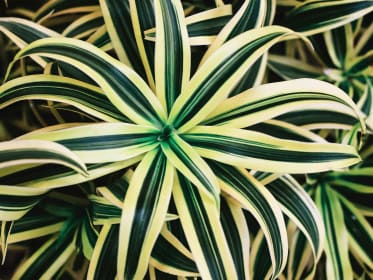
Dragon tree
The dragon tree is an extremely undemanding houseplant that doesn't need much light. Although more light makes the leaf markings on this houseplant stand out much better, it also cuts a good figure in dark corners. A corner will also protect it from cold draughts, which must be avoided. If the leaves on your dragon tree start to turn brown, it's usually because it isn't being watered enough and the root ball is gradually drying out. Although a dragon tree needs a lot of water, it shouldn't be kept excessively wet. A little care and intuition is called for here! As a tropical plant, you can also spray the dragon tree regularly with decalcified water or a leaf care spray. It's also advisable to remove any dust from the leaves beforehand. This makes your dragon tree's air-purifying properties more effective, too. By the way, this also makes the dragon tree a popular plant for the bedroom, study or office.
Warning! Pets like a cat may suffer from stomach problems if they nibble on a dragon tree. Accordingly, it's advisable to choose another shade-loving houseplant if you have a pet.

Lucky bamboo
Despite its name, lucky bamboo does not belong to the Bamboo family – it's actually a dragon tree. Accordingly, a warm and bright location with high levels of humidity is ideal. Although – just like the dragon tree – lucky bamboo can cope with less light, its growth is far slower in poorly lit locations. Lucky bamboo is often kept in a hydroponics growing system, as this is the easiest way to supply the roots with moisture without exposing them to waterlogging. This minimises the risk of damage to the roots due to drying out or excessive moisture. If you use a hydroponics growing system, remembering to fertilise regularly is extremely important because the plant cannot draw nutrients from the substrate. Fertiliser should be added every ten days or so.
Warning! Lucky bamboo is poisonous and therefore not recommended for homes with children or pets.

Spider plant
The spider plant is extremely adaptable when it comes to location. Although it favours bright areas, where the leaf stripes are able to properly develop, the spider plant also makes for an excellent houseplant in dark corners if you're willing to settle for a less impressive leaf decoration. With its long leaves, you can then put the spider plant in a hanging planter, for example. The spider plant is extremely robust and easy to care for and as such often used as an office plant. Its thick, water-retaining roots enable the spider plant to survive the odd dry spell. Of course, it's better to remember to water the plant regularly, preferably once a week. Feel the top layer of soil to see if it is dry before you water the plant, as only then should you reach for the watering can. It's important to remember that waterlogging must always be avoided. Find out what else you can do for your spider plant in our plant guide.

Devil's ivy
Bright, semi-shaded or shaded location? Anything goes with devil's ivy! But like many other houseplants, it prefers a bright spot. If you want to put the plant in a shaded part of the room, then choose a variety with leaves that are as dark as possible, as they need less light than their relatives with lighter, patterned leaves. Since devil's ivy loves humidity, the bathroom makes for a great location.
Warning! Devil's ivy is poisonous and should be kept out of reach of children and pets. But this is not usually a problem, as devil's ivy is particularly effective as a hanging plant. Alternatively, you can also let the climbing plant grow downwards from the top of a shelf. In any case, growth is slower in dark locations, so the risk of children or pets reaching the plant is reduced. In addition, regular pruning can keep the climber in check. However, remain cautious and choose a different plant that can cope with poorly lit locations if in doubt.
Find out more about caring for devil's ivy here:
This might also interest you
Suitable products







